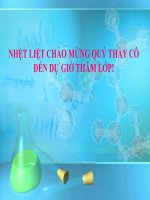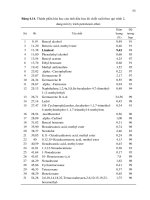Nucleic acids và tính chất hóa học, hóa sinh học
Bạn đang xem bản rút gọn của tài liệu. Xem và tải ngay bản đầy đủ của tài liệu tại đây (72.99 KB, 11 trang )
Nucleic Acids
DNA & RNA
What are they ?
The 4th type of
macromolecules
The chemical link between
generations
The source of genetic
information in chromosomes
What do they do ?
Dictate amino-acid
sequence in proteins
Give information to
chromosomes, which is then
passed from parent to
offspring
What are they made of ?
Simple units called nucleotides,
connected in long chains
Nucleotides have 3 parts:
1- 5-Carbon sugar (pentose)
2- Nitrogen containing base
(made of C, H and N)
3- A phosphate group ( P )
The P groups make the links that
unite the sugars (hence a “sugarphosphate backbone”
Two types of Nucleotides
(depending on the sugar they
contain)
1- Ribonucleic acids (RNA)
The pentose sugar is Ribose
(has a hydroxyl group in the 3rd
carbon---OH)
2- Deoxyribonucleic acids (DNA)
The pentose sugar is
Deoxyribose (has just an
hydrogen in the same place--H)
Deoxy = “minus oxygen”
DNA Nucleotides
Composition (3 parts):
1- Deoxyribose sugar (no O in 3rd
carbon)
2- Phosphate group
3- One of 4 types of bases (all
containing nitrogen):
- Adenine
- Thymine (Only in DNA)
- Cytosine
- Guanine
RNA Nucleotides
Composition ( 3 parts):
1- Ribose sugar (with O in 3rd
carbon)
2- Phosphate group
3- One of 4 types of bases (all
containing nitrogen):
- Adenine
- Uracyl (only in RNA)
- Cytosine
- Guanine
DNA vs RNA
DNA
1- Deoxyribose sugar
2- Bases: Adenine, Thymine, Cytosine,
Guanine
3- Double-stranded helix arrangement
RNA
1- Ribose sugar
2- Bases: Adenine, Uracyl, Cytosine,
Guanine
4- Single stranded
The Double Helix (DNA)
Structural model:
Model proposed by Watson & Crick, 1953
Two sugar-phosphate strands, next to each
other, but running in opposite directions.
Specific Hydrogen bonds occur among bases
from one chain to the other:
A---T
,
C---G
Due to this specificity, a certain base on
one strand indicates a certain base in the
other.
The 2 strands intertwine, forming a
double-helix that winds around a central
axis
How DNA Works
1- DNA stores genetic information in
segments called genes
2- The DNA code is in Triplet Codons
(short sequences of 3 nucleotides
each)
3- Certain codons are translated by
the cell into certain Amino
acids.
4. Thus, the sequence of nucleotides in
DNA indicate a sequence of Amino
acids in a protein.









